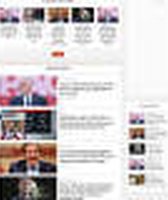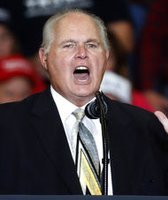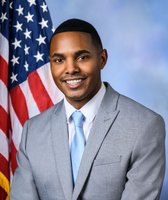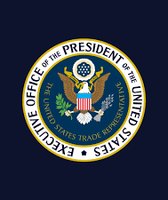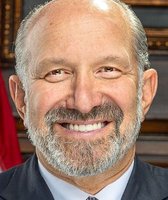Stand up for the facts!
Our only agenda is to publish the truth so you can be an informed participant in democracy.
We need your help.
I would like to contribute
The Internet has the power to advance democratic ideals by making knowledge more accessible and helping voters make more informed choices.
But the picture painted by witnesses at a March 30 bipartisan Senate hearing — a group that included academics, former intelligence officers, and cyber-security consultants — shows how the Internet also makes those ideals vulnerable.
All six witnesses agreed that Russia was behind a misinformation and propaganda campaign intended to disrupt the 2016 U.S. presidential election.
Their testimony went beyond the Jan. 6, 2017, intelligence community report that concluded Russian President Vladimir Putin himself "ordered an influence campaign in 2016 aimed at the U.S. presidential election." The six witnesses described Russia’s tactics as a modern version of Cold War "active measures," a Soviet-coined tactic for disrupting and influencing the politics of its enemies.
They said the Kremlin likely considers the active measures campaign a success, even if it didn’t directly change the tide of the election.
Sign up for PolitiFact texts
For the United States to stave off future misinformation campaigns coming from Russia, they recommended building up cyber defense, quickly diffusing false stories and conspiracy theories, and working with social media companies to tackle the problem of fake and auto-generated profiles.
Given that addressing misinformation is our bread and butter here at PolitiFact, we wanted to provide readers with four key takeaways from the hearing.
1. The experts believe Russia staged a misinformation campaign during the election.
After a two-decade lull, Russia ramped up its active measures against the United States, starting around 2014. These measures range from hacking private accounts of high-profile targets to utilizing social media to spread fake news promoting Russia’s interests. It even created automated bots to create American-seeming social media accounts to help push its narratives. These efforts accelerated amid the 2016 election.
Cybersecurity analysts are confident that Russian intelligence operatives hacked groups like the Democratic National Committee and Hillary Clinton campaign staffers, and subsequently leaked what they found, because of the trail of clues left behind. A simple example: Analysts can see that the attackers operated during business hours in Moscow and St. Petersburg 98 percent of the time, and they speak Russian, said Kevin Mandia, CEO of security firm FireEye.
Several of the experts also noticed a pattern of state-backed Russian media, like RT and Sputnik, pushing exaggerated or false stories that would spread on social media, get picked up by English-speaking conspiratorial websites, and sometimes make it into the hands of then-candidate Donald Trump — such as the time he made an incorrect claim about the 2012 Benghazi attack that might have stemmed from a Sputnik article.
"It is the totality of Russian efforts in plain sight to mislead, to misinform, to exaggerate that is more convincing than any cyber evidence. RT, Russia Today broadcasts, Internet trolls, fake news and so on, are an integral part of Russian foreign policy to date," said Eugene Rumer, a former intelligence officer and director of the Russia and Eurasia Program at the Carnegie Endowment for International Peace.
2. The Russian government’s intent was not simply to elect Trump or defeat Clinton. More than that, its intent was to disrupt American democracy.
The experts said Russian officials would like Western leaders to be sympathetic to their worldview, which is why it’s logical they would support Trump, who has expressed skepticism of NATO and the European Union. But beyond that, Russia wanted to worsen partisanship and cause distrust of political institutions to make American democracy unstable.
That might be a reason why there’s no evidence Russian actors tampered with actual vote counts, but they did access voter rolls in a few states. Russia would rather subtly create a "pin-prick perception" that the election may be rigged than actually rig it, said Clint Watts, senior fellow at the Foreign Policy Research Institute and former FBI special agent.
In ramping up its efforts during the 2016 presidential election, Russia was being opportunistic because of how much polarization exists in American politics, said Thomas Rid, war studies professor at King’s College London.
"The tried and tested way of active measures is to use an adversary's existing weaknesses against himself, to drive wedges into pre-existing cracks," Rid said. "The more polarized a society, the more vulnerable it is. And America in 2016, of course, was highly polarized, with lots of cracks to drive wedges into, but not old wedges, improved high-tech wedges that allowed the Kremlin's operatives to attack their target faster, more reactively and at a far larger scale than ever before."
3. The perpetrators were both overt and covert — and, in some cases, they didn’t know they were participating.
A group of researchers that includes Watts divided the active measures actors into three groups:
-
white - overt Russian propaganda and state-sponsored media;
-
grey - sources with uncertain ties to Russia, such as WikiLeaks and conspiracy-minded websites; and
-
black - covert operators, like hackers or fake social media accounts produced on a mass scale.
WikiLeaks hasn’t confirmed that it received Democratic Party emails from a Russian actor, but analysts generally believe that’s what happened. It’s possible Wikileaks and other media outlets were "unwitting agents" of Russia, pursuing their own goals without realizing or considering that they were also advancing Russia’s agenda. During the Soviet era, disinformation specialists preferred to exploit these "unwitting agents," Rid said.
"There is no contradiction in their reading between being an honest American patriot and at the same time furthering the cause of Russia," Rid said.
Relatedly, Watts said Russian actors control fake social media accounts designed to look American, in hopes that actual Americans would be more likely to believe and repost false or pro-Russian narratives coming from those accounts.
4. It’s going to continue, especially because Putin likely sees the election intervention as a success.
Rumer said Russia’s actions paid off by causing a "major distraction" in the United States, damaging the United States’ global reputation, and demonstrating that Russia is able to trip up a superpower.
"This is not a crisis, not something that will pass soon. It is the new normal," Rumer said. "We will see Russia relying on this toolkit in the months and years to come, in the upcoming elections in France and in Germany this year and in our own future political campaigns. Deception and active measures have long been and will remain a staple of Russia dealings with the outside world for the foreseeable future."
Watts says he’s still seeing evidence of Russia-related social media accounts tweeting at Trump when they think he might be online, in hopes he’ll push a particular conspiracy theory. But Russia won’t necessarily want to prop up Trump and his followers forever because they change who they target based on their goals.
"They might go after a Republican person in this room tomorrow, and then they'll switch," Watts said. "It's solely based on what they want to achieve in their own landscape, whatever the Russian foreign policy objectives are."
Our Sources
CQ, Senate Select Intelligence Committee Hearing on Russian Intelligence Activities transcript, March 30, 2017
War on the Rocks, "Trolling for Trump: How Russia Is Trying to Destroy Our Democracy," Nov. 6, 2016






















